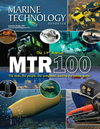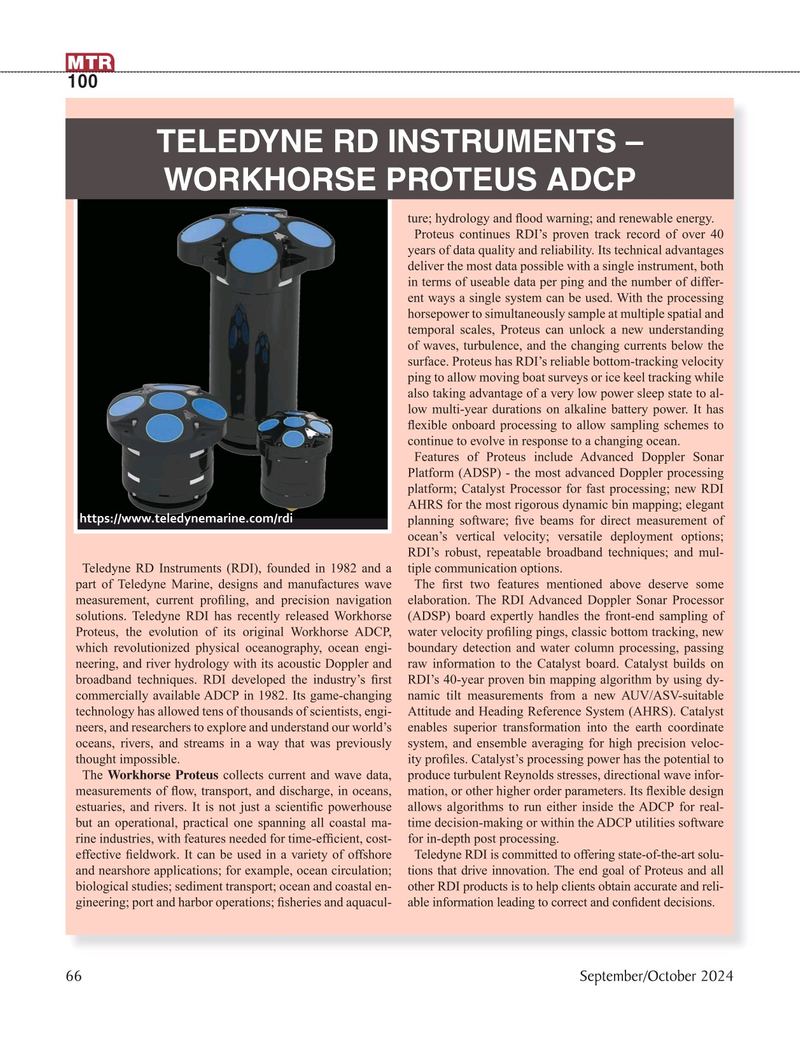
Page 66: of Marine Technology Magazine (September 2024)
Read this page in Pdf, Flash or Html5 edition of September 2024 Marine Technology Magazine
MTR 100
TELEDYNE RD INSTRUMENTS –
WORKHORSE PROTEUS ADCP ture; hydrology and ? ood warning; and renewable energy.
Proteus continues RDI’s proven track record of over 40 years of data quality and reliability. Its technical advantages deliver the most data possible with a single instrument, both in terms of useable data per ping and the number of differ- ent ways a single system can be used. With the processing horsepower to simultaneously sample at multiple spatial and temporal scales, Proteus can unlock a new understanding of waves, turbulence, and the changing currents below the surface. Proteus has RDI’s reliable bottom-tracking velocity ping to allow moving boat surveys or ice keel tracking while also taking advantage of a very low power sleep state to al- low multi-year durations on alkaline battery power. It has ? exible onboard processing to allow sampling schemes to continue to evolve in response to a changing ocean.
Features of Proteus include Advanced Doppler Sonar
Platform (ADSP) - the most advanced Doppler processing platform; Catalyst Processor for fast processing; new RDI
AHRS for the most rigorous dynamic bin mapping; elegant https://www.teledynemarine.com/rdi planning software; ? ve beams for direct measurement of ocean’s vertical velocity; versatile deployment options;
RDI’s robust, repeatable broadband techniques; and mul-
Teledyne RD Instruments (RDI), founded in 1982 and a tiple communication options.
part of Teledyne Marine, designs and manufactures wave The ? rst two features mentioned above deserve some measurement, current pro? ling, and precision navigation elaboration. The RDI Advanced Doppler Sonar Processor solutions. Teledyne RDI has recently released Workhorse (ADSP) board expertly handles the front-end sampling of
Proteus, the evolution of its original Workhorse ADCP, water velocity pro? ling pings, classic bottom tracking, new which revolutionized physical oceanography, ocean engi- boundary detection and water column processing, passing neering, and river hydrology with its acoustic Doppler and raw information to the Catalyst board. Catalyst builds on broadband techniques. RDI developed the industry’s ? rst RDI’s 40-year proven bin mapping algorithm by using dy- commercially available ADCP in 1982. Its game-changing namic tilt measurements from a new AUV/ASV-suitable technology has allowed tens of thousands of scientists, engi- Attitude and Heading Reference System (AHRS). Catalyst neers, and researchers to explore and understand our world’s enables superior transformation into the earth coordinate oceans, rivers, and streams in a way that was previously system, and ensemble averaging for high precision veloc- thought impossible. ity pro? les. Catalyst’s processing power has the potential to
The Workhorse Proteus collects current and wave data, produce turbulent Reynolds stresses, directional wave infor- measurements of ? ow, transport, and discharge, in oceans, mation, or other higher order parameters. Its ? exible design estuaries, and rivers. It is not just a scienti? c powerhouse allows algorithms to run either inside the ADCP for real- but an operational, practical one spanning all coastal ma- time decision-making or within the ADCP utilities software rine industries, with features needed for time-ef? cient, cost- for in-depth post processing.
effective ? eldwork. It can be used in a variety of offshore Teledyne RDI is committed to offering state-of-the-art solu- and nearshore applications; for example, ocean circulation; tions that drive innovation. The end goal of Proteus and all biological studies; sediment transport; ocean and coastal en- other RDI products is to help clients obtain accurate and reli- gineering; port and harbor operations; ? sheries and aquacul- able information leading to correct and con? dent decisions. 66 September/October 2024
MTR #7 (66-79).indd 66 10/8/2024 2:07:54 PM

 65
65

 67
67
